 |
Last Update:
Friday November 23, 2018
|
| [Home] |
|
IUCN/SCC Otter Specialist Group Bulletin Volume 9 Pages 1 - 16 (March 1994) Citation: Madsen, A.B. & Søgaard, B. (1994) Stop-Grids for Fish Traps in Denmark. IUCN Otter Spec. Group Bull. 9: 13 - 14 Stop-Grids for Fish Traps in Denmark Aksel Bo Madsen1 and Bjarne Søgaard2 1National Environmental Research institute, Department of Wildlife Ecology, Grenåvej 12, DK-8410 Rønde, Denmark
Stop-grids that fit into the inner end of the first fyke tunnel of fish traps have been tested and used by experienced Danish trap fishers since 1986. The results are positive and have been published in the Proceedings of the Vth International Otter Colloquium, Habitat 6, Hankensbüttel, 1991 pp 237 - 241, entitled "Otter (Lutra lutra) mortalities in fish traps and experiences with using stop-grids in Denmark". From 1 January 1991, the Danish Ministry of Fishery has lain down that all trap fishers using fish traps in otter habitats must use stop-grids or stop-net in their fish traps. If the trap fisher ignores this regulation, the penalty per fish-trap without stop-grid is DM 175, or $110, and the tool will be confiscated. During the last two years, the National Forest and Nature Agency and The National Environmental Research Institute have been negotiating with the Danish Ministry of Fishery for an extension of the law of 1991.
The stop-grid is a reasonable compromise between on one hand, protection of the otter population on, the other fishing interests. Two types of stop-grids are approved by the authorities in Denmark: one rigid, square, made of plastic (180 mm x 180 mm) and one rigid, square, made of steel (268 mm x 268 mm), both with 85 mm bar length (Figure 2).
Both types of stop-grids are manufactured and sold by the Centre of Technology and Product Development in the County of Aarhus:
|
|||||||||||
| [Copyright © 2006 - 2050 IUCN/SSC OSG] | [Home] | [Contact Us] |

